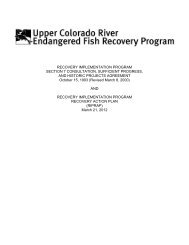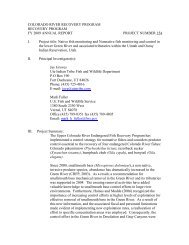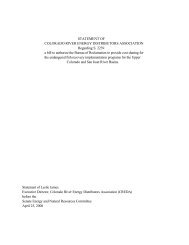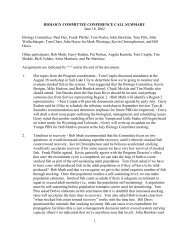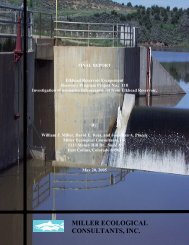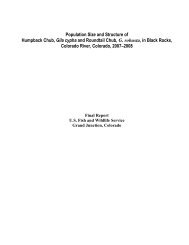K. R. Bestgen, K. A. Zelasko, and G. C. White. Monitoring ...
K. R. Bestgen, K. A. Zelasko, and G. C. White. Monitoring ...
K. R. Bestgen, K. A. Zelasko, and G. C. White. Monitoring ...
You also want an ePaper? Increase the reach of your titles
YUMPU automatically turns print PDFs into web optimized ePapers that Google loves.
Survival of relatively large (> 250 mm TL) hatchery-reared razorback suckers released into the<br />
Green <strong>and</strong> Colorado rivers has increased population abundance <strong>and</strong> some are now reproducing,<br />
including in the middle <strong>and</strong> lower Green rivers <strong>and</strong> for the first time, in the lower <strong>White</strong> River in<br />
2011 (Burdick 2003; Modde et al. 2005; <strong>Zelasko</strong> 2008; Osmundson <strong>and</strong> Seal 2009; <strong>Zelasko</strong> et al.<br />
2009; <strong>Zelasko</strong> et al. 2010, <strong>Bestgen</strong> et al. 2011, A. Webber, USFWS, Vernal, Utah). Razorback<br />
sucker in the Colorado River, Utah <strong>and</strong> Colorado, are also reproducing (Osmundson <strong>and</strong> Seal<br />
2009). Thus, a program to monitor population distribution, reproduction, recruitment, <strong>and</strong> status<br />
in the Upper Colorado River Basin is appropriate at this time.<br />
Our objective was to detail a procedure to monitor status <strong>and</strong> trends for razorback sucker<br />
populations in the Green <strong>and</strong> Colorado River systems of the Upper Colorado River Basin <strong>and</strong><br />
specifically to 1) compile literature <strong>and</strong> sampling data relevant to underst<strong>and</strong>ing early life <strong>and</strong><br />
adult razorback sucker distribution <strong>and</strong> ecology, 2) conduct analyses appropriate to<br />
underst<strong>and</strong>ing sampling intensity, <strong>and</strong> 3) make recommendations for sampling. Data gathered<br />
will be useful to document important life history parameters <strong>and</strong> vital rates, identify roadblocks<br />
to conservation, <strong>and</strong> ultimately, quantify measures of population success that will indicate when<br />
recovery has been achieved. We consider sampling programs for early life stages, juveniles, <strong>and</strong><br />
adults, using existing studies <strong>and</strong> associated data as well as suggestions for obtaining new<br />
information. We also detail potentially problematic issues which will enable better parameter<br />
estimation <strong>and</strong> monitoring to detect trends.<br />
STUDY AREA<br />
The main study area was the Green River from the confluence of the Yampa River<br />
downstream to the confluence with the Colorado River, <strong>and</strong> warmwater reaches of the Colorado<br />
River <strong>and</strong> lower Gunnison River from upstream of Gr<strong>and</strong> Junction downstream to Moab, Utah<br />
(Figure 1). Future sampling may include downstream areas including the Lake Powell inflow.<br />
METHODS<br />
We used literature, existing information, <strong>and</strong> personal experience of the authors <strong>and</strong><br />
others who have conducted field sampling to first identify information that is known about<br />
razorback sucker. Key information was underst<strong>and</strong>ing the history <strong>and</strong> reasons for decline of<br />
8




